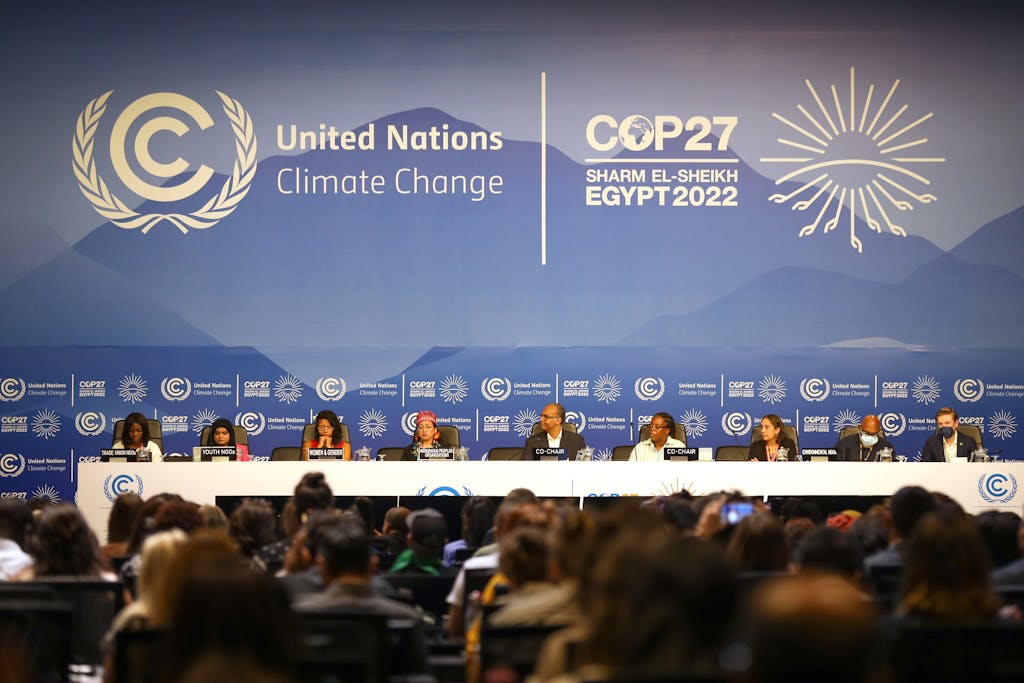Climate change jargon can be confusing. In fact, a 2021 study found that most U.S. residents struggle to understand several of the most common climate terms, including “adaptation.” So what is climate adaptation, why does it matter, and why is the climate community zeroing in on the Global Goal on Adaptation? Cristina Rumbaitis del Rio and Evelin Tóth explain.
What is climate adaptation, and why does it matter?
Climate change poses a significant threat to humanity, with widespread and severe consequences for people, the natural world, and the global economy. The impacts of climate change can be felt across the globe, threatening ecosystems, human settlements, and infrastructure. Importantly, those who contributed least to climate change tend to be disproportionately at risk from its impacts.
Increasing and intensifying weather extremes have reduced food and water security and have already adversely affected human health and livelihoods as well as infrastructure. These compounding impacts are hindering efforts to meet the Sustainable Development Goals (SDGs). And, alarmingly, there is growing evidence that climate change is exacerbating conflict, driving human displacement, and worsening vulnerability.
Adaptation, then, refers to taking actions to reduce the negative impacts of climate change and build resilience to climate-related shocks and stresses across all systems. These actions can include changes in processes and practices as well as physical changes to the environment to better manage climate impacts — both by mitigating potential damages and seizing opportunities as a result of climate change.
In the absence of effective climate change adaptation, climate impacts will continue to negatively affect millions of people around the globe — with ever-increasing impacts with every fraction of global warming.

The 61st and Peña Station in Denver, Colorado. The Wash U–St. Louis team designed the CRETE solar house that can collect rainwater in its large visible gutters which also serve as a source of shade for each window. Photo: Dennis Schroeder/U.S. Department of Energy Solar Decathlon
What is the state of climate adaptation globally?
Adaptation action globally has fallen short of what is required to ensure that everyone around the world is climate-safe, both in terms of the amount of finance flowing and the types of adaptation activities that are being implemented around the world.
In its February 2022 report, the Intergovernmental Panel on Climate Change (IPCC) described adaptation action to date as small in scale, incremental, and fragmented with little evidence of transformational adaptation. What’s more, adaptation actions typically do not address longer-term climate impacts, which may reinforce existing vulnerabilities and make it more difficult and costly to course-correct in the future.
International adaptation finance flows to developing countries amounted to $29 billion in 2020. This is less than 10% of what is required by 2030, which is estimated at $340 billion per year, and far less than what will be needed in the decades that follow. Increasing adaptation finance globally is critical, as countries in Africa already spend 2–9% of their GDP on adaptation — an amount that in some cases represents more than their spending on health care, education, or other public services.
What is the UN’s role in driving global adaptation action?
Governments have a unique opportunity this year to drive progress on adaptation through a UN process known as the Glasgow–Sharm el-Sheikh work program on the global goal on adaptation. The two-year “GlaSS” program was created to bring governments together to help flesh out what constitutes elements of a “global goal on adaptation” and how this goal can be measured and achieved.
In 2015, the UN-brokered Paris Agreement established a Global Goal on Adaptation (GGA) that seeks to enhance countries’ capacity to adapt, strengthen resilience, and reduce vulnerability to climate change. While this was an important step forward in building shared accountability globally for adaptation, there was little clarity on the elements of the goal and how progress toward the goal would be measured.
The 26th UN Climate Change Conference (COP 26) held in Glasgow, Scotland, in 2021 was a major milestone in the process, as governments decided to establish GlaSS to help flesh out the Global Goal on Adaptation. The program calls for eight workshops to be held prior to the 28th UN Climate Change Conference (COP 28) in the United Arab Emirites city of Dubai in late 2023, where negotiators are to finalize a framework for the global goal on adaptation.
As the negotiations are progressing on a technical level in the coming months, it is important to call for a robust, ambitious, and solutions-oriented outcome by COP 28 to help accelerate adaptation action globally.

To combat rising seas, workers plant adaptation mangroves in the bay opposite Kingston, Jamaica. Photo: Kadir van Lohuizen/NOOR
Why does the Global Goal on Adaptation matter to all of us?
Agreeing to a strong framework for the GGA can not only clarify existing adaptation gaps and needs, but also ensure transparency and accountability at all levels while providing a platform for knowledge sharing on key adaptation issues.
The GGA can be an effective tool to measure progress toward collective climate adaptation goals — such as the UN Secretary-General’s call to provide everyone on Earth with access to early warning systems by 2027 — while holding leaders at every level accountable for taking the actions needed to keep individuals, communities, ecosystems, and economies climate-safe. At the same time, because adaptation is still a relatively new area of practice, the GGA framework can help set a learning agenda for building resilience so that adaptation action is more effective, efficient, and equitable in all parts of the world.
In doing so, the GGA can deliver a more resilient and prosperous future for everyone in the following ways:
- Driving climate action more broadly – including in the context of mitigation and loss and damage. Many of the most effective adaptation options we have, such as ecosystem protection and nature-based solutions like mangrove restoration or the greening of urban areas, can help deliver both adaptation and mitigation (that is, actions that reduce the amount of climate change-causing greenhouse gases in the atmosphere). Elevating the types of activities that deliver benefits for both climate adaptation and mitigation can help communities build resilience while avoiding emissions or sequestering greenhouse gases. At the same time, catalyzing adaptation action globally through a strong GGA will help communities avert losses and damages associated with climate impacts.
- Catalyzing action to make the world a safer, more prosperous place for all. Adaptation is not a concern just for vulnerable countries and communities. We are all connected through an intricate web of global economic, social, and political ties. Climate impacts cascade across national boundaries. Enhancing people’s resilience across the globe will make everyone safer.

A view of the dais during the Opening Plenary Session at COP 27, the UN’s Climate Change Conference held in 2022. Photo: Kiara Worth / UN
As we approach the next UN Climate Change Conference (COP 28), countries have an opportunity to seize this moment to catalyze adaptation action globally. By ensuring that climate resilience is at the heart of everything we do, we can collectively strive for a future that is climate-safe, sustainable, and equitable for all.
CATALYZING CLIMATE ADAPTATION ON THE ROAD TO COP28
A new paper, co-authored by Kaveh Guilanpour at the Center for Climate and Energy Solutions and UN Foundation Senior Advisor Cristina Rumbaitis del Rio, explores what a robust and viable overarching goal for climate adaptation at COP28 could look like. The paper also looks at options for elevating climate adaptation on the global political stage.







